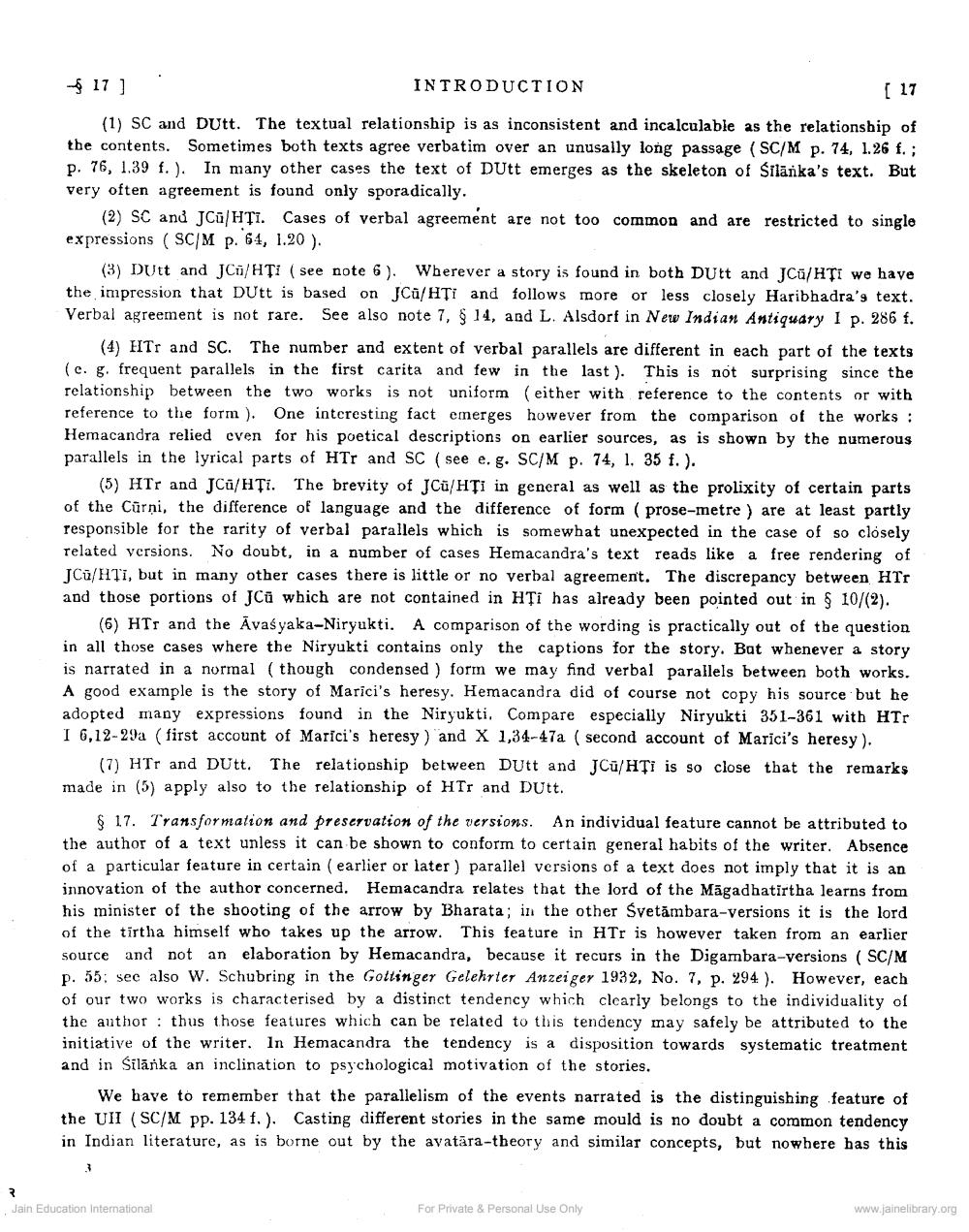________________
17]
INTRODUCTION
[ 17
(1) SC and Dutt. The textual relationship is as inconsistent and incalculable as the relationship of the contents. Sometimes both texts agree verbatim over an unusally long passage (SC/M p. 74, 1.26 f.; p. 76, 1.39 f.). In many other cases the text of DUtt emerges as the skeleton of Silanka's text. But very often agreement is found only sporadically.
(2) SC and JCūHȚI. Cases of verbal agreement are not too common and are restricted to single expressions (SC/M p. 64, 1.20 ).
(3) Dutt and JC/HTI see note 6). Wherever a story is found in both Dutt and JCü/HTI we have the impression that Dutt is based on JCü/HTi and follows more or less closely Haribhadra's text. Verbal agreement is not rare. See also note 7, S 14, and L. Alsdorf in New Indian Antiquary 1 p. 286 f.
(4) HTr and SC. The number and extent of verbal parallels are different in each part of the texts (c. g. frequent parallels in the first carita and few in the last). This is not surprising since the relationship between the two works is not uniform (either with reference to the contents or with reference to the form). One interesting fact emerges however from the comparison of the works : Hemacandra relied even for his poetical descriptions on earlier sources, as is shown by the numerous parallels in the lyrical parts of HTr and SC (see e. g. SC/M p. 74, 1, 35 f.).
(5) HTr and JCū/HTi. The brevity of JCü/HTI in general as well as the prolixity of certain parts of the Cürņi, the difference of language and the difference of form prose-metre ) are at least partly responsible for the rarity of verbal parallels which is somewhat unexpected in the case of so closely related versions. No doubt, in a number of cases Hemacandra's text reads like a free rendering of JCū/H77, but in many other cases there is little or no verbal agreement. The discrepancy between HT and those portions of JCū which are not contained in HTI has already been pointed out in $ 10/(2).
(6) HTr and the Āvasyaka-Niryukti. A comparison of the wording is practically out of the question in all those cases where the Niryukti contains only the captions for the story. But whenever a story is narrated in a normal (though condensed ) form we may find verbal parallels between both works. A good example is the story of Marici's heresy. Hemacandra did of course not copy his source but he adopted many expressions found in the Niryukti. Compare especially Niryukti 351-361 with HTr I 6,12-29a (first account of Marici's heresy) and X 1,34-47a ( second account of Marici's heresy).
(7) HTr and DUtt. The relationship between Dutt and JCū/HTi is so close that the remarks made in (5) apply also to the relationship of HTr and Dutt.
& 17. Transformation and preservation of the versions. An individual feature cannot be attributed to the author of a text unless it can be shown to conform to certain general habits of the writer. Absence of a particular feature in certain earlier or later) parallel versions of a text does not imply that it is an innovation of the author concerned. Hemacandra relates that the lord of the Mägadhatirtha learns from his minister of the shooting of the arrow by Bharata; in the other Svetambara-versions it is the lord of the tirtha himself who takes up the arrow. This feature in HTr is however taken from an earlier source and not an elaboration by Hemacandra, because it recurs in the Digambara-versions (SC/M p. 55; see also W. Schubring in the Gottinger Gelehrter Anzeiger 1932, No. 7, p. 294). However, each of our two works is characterised by a distinct tendency which clearly belongs to the individuality of the author : thus those features which can be related to this tendency may safely be attributed to the initiative of the writer. In Hemacandra the tendency is a disposition towards systematic treatment and in Silanka an inclination to psychological motivation of the stories.
We have to remember that the parallelism of the events narrated is the distinguishing feature of the UII (SC/M pp. 134 f.). Casting different stories in the same mould is no doubt a common tendency in Indian literature, as is borne out by the avatāra-theory and similar concepts, but nowhere has this
Jain Education International
For Private & Personal Use Only
www.jainelibrary.org




